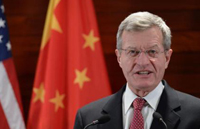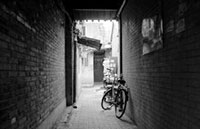Pious painting
By Chen Nan (China Daily) Updated: 2012-11-26 03:03An ongoing exhibition of Tibetan thangka pieces retreats from the genre's commercialization. Chen Nan reports.
Tibetan Zekyid spent more than three months working on his painting, The Pure Land of Sakyamuni Buddha.
It depicts Sakyamuni teaching his two disciples. Standing above are Manjushri — the embodiment of wisdom — and White Tara — who represents the virtues of work and good health.
The 28-year-old from Sichuan province's Garze Tibetan autonomous prefecture paints thangka, the distinctive Tibetan scrolls that depict the ethnic group's deities.
The radiant circles around the figure are golden. The colorful clothes, animals, flowers and clouds are rendered using natural pigments ground from minerals, coral and plants.
Zekyid paints at least 10 hours a day. He says he never feels bored and his heart is tranquil while painting.
He applies a traditional Tibetan ointment to soothe his eyes after working.
Zekyid's painting was displayed at the National Museum of China in September and is now on show at The Flavor of The Sun — Thangka Art Exhibition at SkyMoca art museum in Beijing's 798 Art Zone.
Zekyid and nine other young thangka painters — all Tibetans ages 18-28 from Sichuan and Qinghai provinces — are showing 40 paintings they created over the past 14 months.
"Painting these sacred images not only demands great patience and focus but also a pure heart," Zekyid says.
He loved drawing birds and trees in his childhood and started studying thangka painting at 19.
"Painting makes me happy," he says.
"I want to share thangka culture with people and pass it down to another generation."
Thangka has been included on the National Intangible Cultural Heritage List since 2006. The show's artists practice the Menbris style of thangka painting that has flourished since the 15th century.
The 10 painters, who have studied thangka for more than seven years, come from Pandedajie School, founded by Fujian province native Zhang Li.
Zhang, who has owned two real estate consulting companies, visited Tibet in 2000. She fell in love with the pure and holy land, and was especially amazed by thangka, which she first saw in an ancient temple.
Her understanding of money transformed when she realized her 2,000 yuan ($321) jeans cost as much as a semester of school for 200 students.
"I don't want to give them money or donate clothes because that doesn't comprehensively solve the problem," she says.
In 2003, she decided to open a charitable school that offers free classes to poor students.
The name, Pandedajie, according to Zhang, means "benefiting others" and "spreading" in Tibetan.
The school offers sustainable ways to help children learn skills and earn livings after graduation. Zhang visited Tibet's temples to find teachers. A year later, the school opened in Lhasa.
The school's teacher is 46-year-old Phuntso Dorje, who was born in Xigaze.
He became a monk at 16 and learned thangka painting under Tashilhunpo Monastery's chief painter Kelsangla for four years.
Since then, he has continued to study with Lozangla, the painter of 10th Panchen Lama of the Tashilhunpo Monastery.
He also became the first person to publish an instructional book about thangka painting in 2006.
The painters always start with the deities' heads. They must know Tibetan and Buddhist history, and also be skilled at fresco painting and repair.
The deities express their thoughts through specific hand gestures. There are many rules about their depictions that have been passed down for centuries.
Students can graduate from Zhang's school in six years.
Several talented and knowledgeable students, such as Zekyid, have started to express their own understandings of Buddhism through thangka paintings, Zhang says.
More than 400 of the 500 students who've studied at the school since its founding have jobs.
Those who haven't found other work are employed by the culture company Zhang opened in 2011.
The thangka exhibition was first staged in SkyMoca in 2011, and Zhang plans to hold it annually.
Her school's students also learn sculpting and other traditional Tibetan arts, such as embroidery and knitting.
She plans to organize an exhibition of bronze sculptures in 2013.
Three of the ongoing exhibition's painters are women.
Women are traditionally forbidden from thangka painting, as it was the sacred realm of monks.
One of these women, 18-year-old Sonam Shagmo, came to the school three years ago with her 20-year-old sister Dorjemtsho. "I thought only men could paint thangka, but after I studied it, I feel it's magical," she says.
Her piece displays Manjushri.
Thangka pieces have been growing in popularity outside of Tibetan areas in recent years.
But most works are low-grade reproductions, and authentic pieces are rare.
"Thangka paintings' commercialization has pushed them away from their origins as religious objects," Zhang says.
"The most traditional skills create the most beautiful paintings. But contemporary people ignore this."
Contact the writer at chennan@chinadaily.com.cn.
- What you need to know about Jiangsu's deadly tornado
- China faces challenges in tornado forecast: weather authority
- Ruling may 'open Pandora's box'
- Poverty funds facing stiffer supervision
- Guns a growing factor in narcotics enforcement
- China issues disaster alerts
- Ministry orders removal of substandard running tracks
- HK most expensive for expats
- Agency lists tiny hallway for sale: 1.5 million yuan
- Li vows to boost support for real economy










